Search
- Page Path
- HOME > Search
- Risk factors for SARS-CoV-2 transmission during a movie theater outbreak in Incheon in the Republic of Korea, November 2021: a retrospective study
- Hye Young Lee, Young-Joon Park, Sang-Eun Lee, Han-Na Yoo, Il-Hwan Kim, Jin Sun No, Eun-Jin Kim, Jungyeon Yu, Sanghwan Bae, Mi Yu
- Osong Public Health Res Perspect. 2024;15(1):45-55. Published online January 31, 2024
- DOI: https://doi.org/10.24171/j.phrp.2023.0269
- 10,585 View
- 325 Download
-
 Graphical Abstract
Graphical Abstract
 Abstract
Abstract
 PDF
PDF 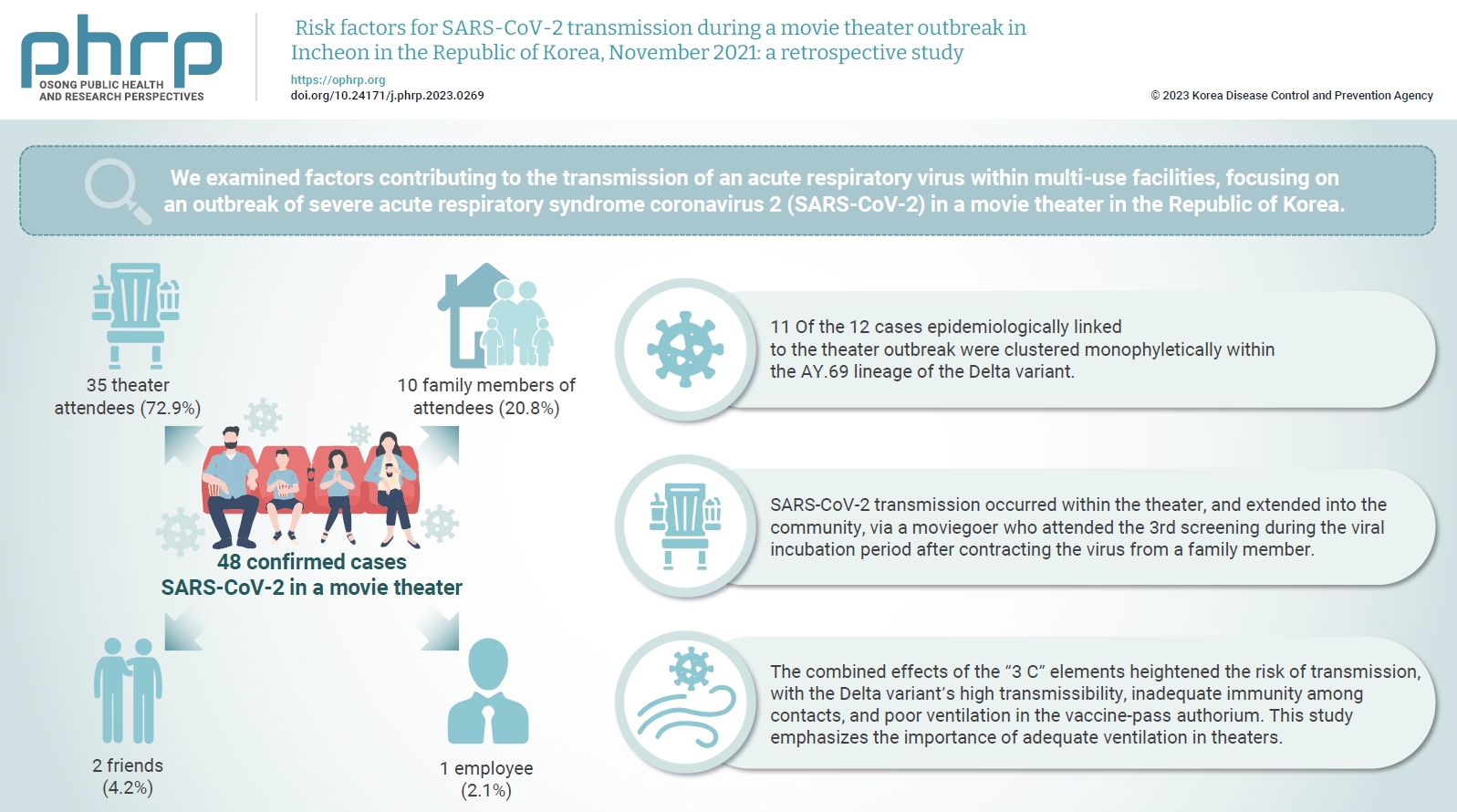
- Objectives
We examined factors contributing to the transmission of an acute respiratory virus within multi-use facilities, focusing on an outbreak of severe acute respiratory syndrome coronavirus 2 (SARS-CoV-2) in a movie theater in the Republic of Korea. Methods: This retrospective cohort study involved a descriptive analysis of 48 confirmed cases. Logistic regression was applied to a cohort of 80 theater attendees to identify risk factors for infection. The infection source and transmission route were determined through gene sequencing data analysis. Results: Of the 48 confirmed cases, 35 were theater attendees (72.9%), 10 were family members of attendees (20.8%), 2 were friends (4.2%), and 1 was an employee (2.1%). Among the 80 individuals who attended the 3rd to 5th screenings of the day, 35 became infected, representing a 43.8% attack rate. Specifically, 28 of the 33 third-screening attendees developed confirmed SARSCoV-2, constituting an 84.8% attack rate. Furthermore, 11 of the 12 cases epidemiologically linked to the theater outbreak were clustered monophyletically within the AY.69 lineage. At the time of the screening, 35 individuals (72.9%) had received 2 vaccine doses. However, vaccination status did not significantly influence infection risk. Multivariate analysis revealed that close contacts had a 15.9-fold higher risk of infection (95% confidence interval, 4.37–78.39) than casual contacts. Conclusion: SARS-CoV-2 transmission occurred within the theater, and extended into the community, via a moviegoer who attended the 3rd screening during the viral incubation period after contracting the virus from a family member. This study emphasizes the importance of adequate ventilation in theaters.
- Evaluation of COVID-19 vaccine effectiveness in different high-risk facility types during a period of Delta variant dominance in the Republic of Korea: a cross-sectional study
- Min Jei Lee, Myung-Jae Hwang, Dong Seob Kim, Seon Kyeong Park, Jihyun Choi, Ji Joo Lee, Jong Mu Kim, Young-Man Kim, Young-Joon Park, Jin Gwack, Sang-Eun Lee
- Osong Public Health Res Perspect. 2023;14(5):418-426. Published online October 19, 2023
- DOI: https://doi.org/10.24171/j.phrp.2023.0188
- 1,278 View
- 44 Download
-
 Graphical Abstract
Graphical Abstract
 Abstract
Abstract
 PDF
PDF 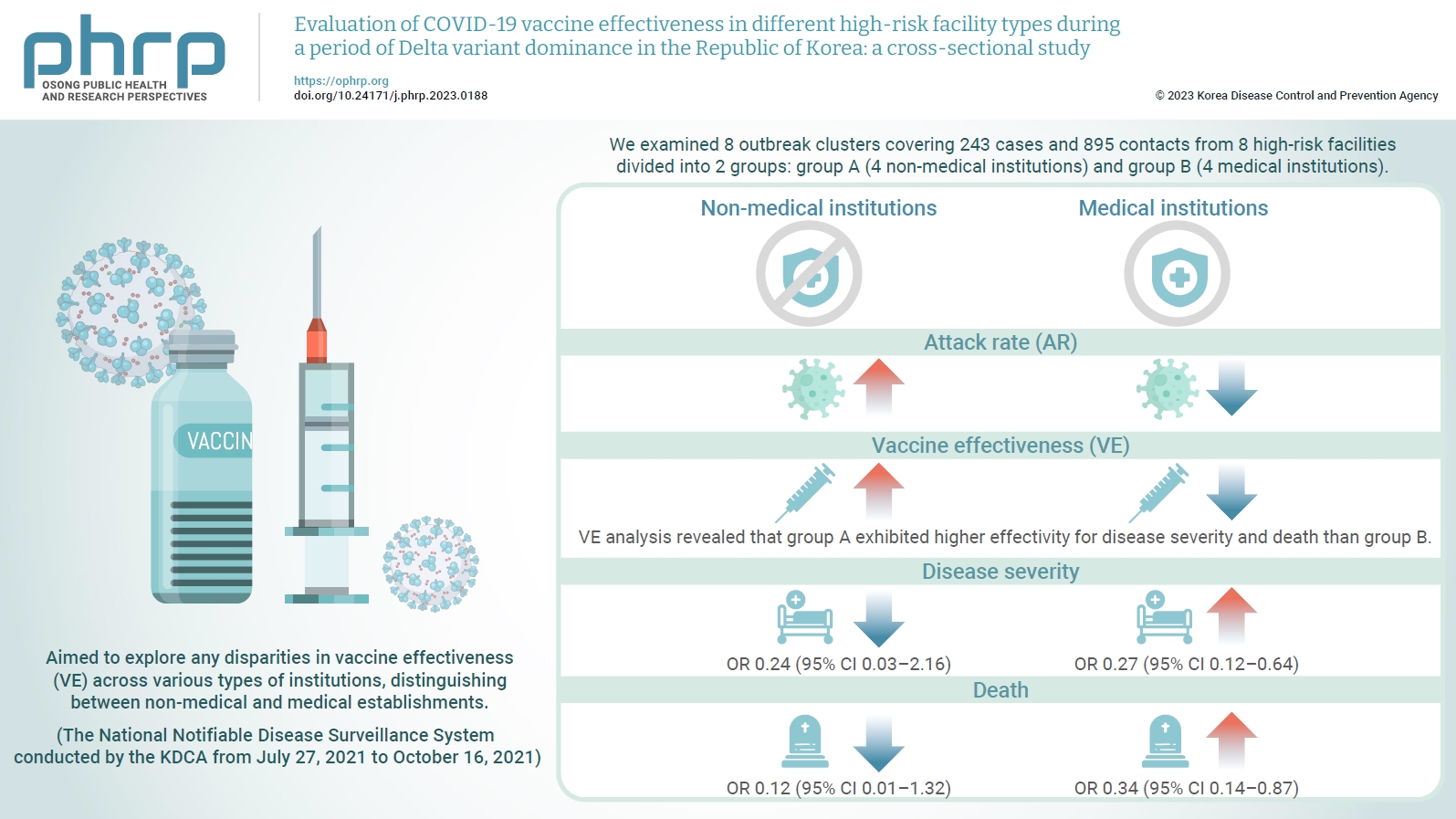
- Objectives
We evaluated the effectiveness of coronavirus disease 2019 vaccination in high-risk facilities in the Republic of Korea during the period when the highly transmissible Delta variant was prevalent. Additionally, we aimed to explore any disparities in vaccine effectiveness (VE) across various types of institutions, specifically distinguishing between non-medical and medical establishments. Methods: We examined 8 outbreak clusters covering 243 cases and 895 contacts from 8 high-risk facilities divided into 2 groups: group A (4 non-medical institutions) and group B (4 medical institutions). These clusters were observed from July 27, 2021 to October 16, 2021 for the attack rate (AR) and VE with respect to disease severity. A generalized linear model with a binomial distribution was used to determine the odds ratio (OR) for disease severity and death. Results: AR was notably lower in group B (medical institutions). Furthermore, VE analysis revealed that group A exhibited higher effectivity for disease severity and death than group B. The OR for disease severity was 0.24 (95% confidence interval [CI], 0.03–2.16) for group A and 0.27 (95% CI, 0.12–0.64) for group B, with the OR for death at 0.12 (95% CI, 0.01–1.32) in group A and 0.34 (95% CI, 0.14–0.87) in group B. Conclusion: Although VE may vary across institutions, our findings underscore the importance of implementing vaccinations in high-risk facilities. Customized vaccination programs, tailored response plans, and competent management personnel are essential for effectively addressing and mitigating public health challenges.
- Household secondary attack rates and risk factors during periods of SARS-CoV-2 Delta and Omicron variant predominance in the Republic of Korea
- Jin Lee, Mijeong Ko, Seontae Kim, Dosang Lim, Gemma Park, Sang-Eun Lee
- Osong Public Health Res Perspect. 2023;14(4):263-271. Published online August 11, 2023
- DOI: https://doi.org/10.24171/j.phrp.2023.0133
- 1,894 View
- 133 Download
-
 Graphical Abstract
Graphical Abstract
 Abstract
Abstract
 PDF
PDF 
- Objectives
The household secondary attack rate (SAR) of severe acute respiratory syndrome coronavirus 2 (SARS-CoV-2) is an important indicator for community transmission. This study aimed to characterize transmission by comparing household SARs and identifying risk factors during the periods of Delta and Omicron variant predominance in Republic of Korea.
Methods
We defined the period of Delta variant predominance (Delta period) as July 25, 2021 to January 15, 2022, and the period of Omicron variant predominance (Omicron period) as February 7 to September 3, 2022. The number of index cases included was 214,229 for the Delta period and 5,521,393 for the Omicron period. To identify the household SARs and risk factors for each period, logistic regression was performed to determine the adjusted odds ratio (aOR).
Results
The SAR was 35.2% for the Delta period and 43.1% for the Omicron period. The aOR of infection was higher in 2 groups, those aged 0 to 18 years and ≥75 years, compared to those aged 19 to 49 years. Unvaccinated individuals (vs. vaccinated individuals) and individuals experiencing initial infection (vs. individuals experiencing a second or third infection) had an increased risk of infection with SARS-CoV-2.
Conclusion
This study analyzed the household SARs and risk factors. We hope that the results can help develop age-specific immunization plans and responses to reduce the SAR in preparation for emerging infectious diseases or potential new variants of SARS-CoV-2.
- Risk factors for transmission in a COVID-19 cluster infection in a high school in the Republic of Korea
- Jin-Hwan Jeon, Su Jin Kang, Se-Jin Jeong, Hyeon-Cheol Jang, Young-Joon Park, Sang-Eun Lee
- Osong Public Health Res Perspect. 2023;14(4):252-262. Published online July 27, 2023
- DOI: https://doi.org/10.24171/j.phrp.2023.0125
- 3,452 View
- 192 Download
- 1 Web of Science
- 1 Crossref
-
 Graphical Abstract
Graphical Abstract
 Abstract
Abstract
 PDF
PDF 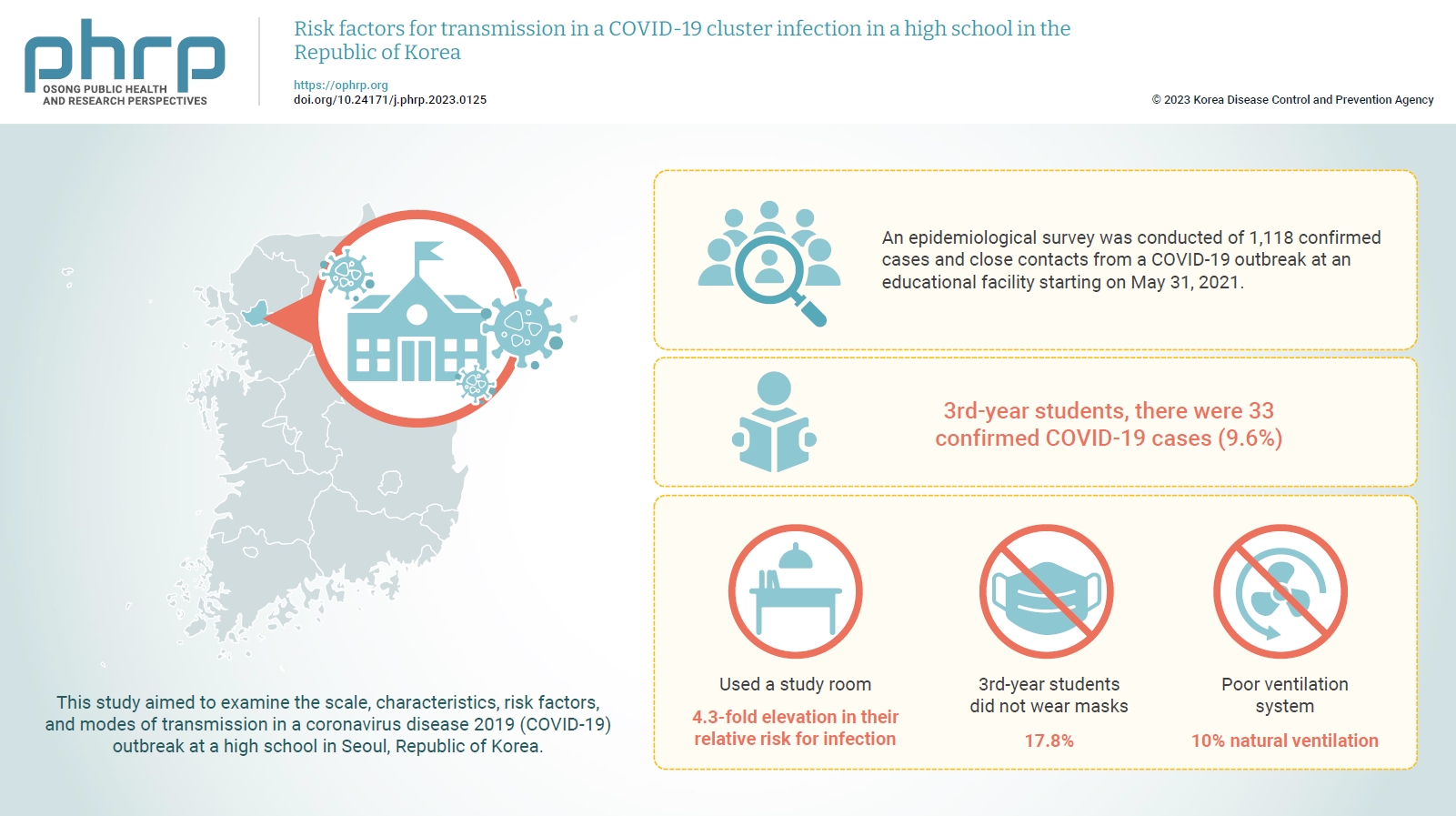
- Objectives
This study aimed to examine the scale, characteristics, risk factors, and modes of transmission in a coronavirus disease 2019 (COVID-19) outbreak at a high school in Seoul, Republic of Korea.
Methods
An epidemiological survey was conducted of 1,118 confirmed cases and close contacts from a COVID-19 outbreak at an educational facility starting on May 31, 2021. In-depth interviews, online questionnaires, flow evaluations, and CCTV analyses were used to devise infection prevention measures. Behavioral and spatial risk factors were identified, and statistical significance was tested.
Results
Among 3rd-year students, there were 33 confirmed COVID-19 cases (9.6%). Students who used a study room in the annex building showed a statistically significant 4.3-fold elevation in their relative risk for infection compared to those who did not use the study room. Moreover, CCTV facial recognition analysis confirmed that 17.8% of 3rd-year students did not wear masks and had the lowest percentage of mask-wearers by grade. The air epidemiological survey conducted in the study room in the annex, which met the 3 criteria for a closed space, confirmed that there was only 10% natural ventilation due to the poor ventilation system.
Conclusion
To prevent and manage the spread of COVID-19 in educational facilities, advance measures that consider the size, operation, and resources of each school are crucial. In addition, various survey methodologies should be used in future studies to quickly analyze a wider range of data that can inform an evidence-based quarantine response. -
Citations
Citations to this article as recorded by- Detection of a cluster of Omicron's BA.4 sublineage in Northern Senegal and identification of the first XAS recombinant variant in Senegal
Martin Faye, Modeste Name Faye, Babacar Ndiaye, Moussa Moïse Diagne, Safietou Sankhe, Ndeye Marième Top, Amadou Diallo, Cheikh Loucoubar, Ndongo Dia, Amadou Alpha Sall, Ousmane Faye
Virus Research.2024; 339: 199259. CrossRef
- Detection of a cluster of Omicron's BA.4 sublineage in Northern Senegal and identification of the first XAS recombinant variant in Senegal
- Results of contact tracing for SARS-CoV-2 Omicron sub-lineages (BA.4, BA.5, BA.2.75) and the household secondary attack risk
- Mi Yu, Sang-Eun Lee, Hye Young Lee, Hye-jin Kim, Yeong-Jun Song, Jian Jeong, Ae Kyung Park, Il-Hwan Kim, Eun-jin Kim, Young-Joon Park
- Osong Public Health Res Perspect. 2023;14(3):173-179. Published online June 22, 2023
- DOI: https://doi.org/10.24171/j.phrp.2022.0285
- 1,375 View
- 58 Download
-
 Graphical Abstract
Graphical Abstract
 Abstract
Abstract
 PDF
PDF 
- Objectives
This study aimed to assess the contact tracing outcomes of severe acute respiratory syndrome coronavirus 2 (SARS-CoV-2) Omicron sub-lineages BA.4, BA.5, and BA.2.75 within Republic of Korea, and to generate foundational data for responding to future novel variants.
Methods
We conducted investigations and contact tracing for 79 confirmed BA.4 cases, 396 confirmed BA.5 cases, and 152 confirmed BA.2.75 cases. These cases were identified through random sampling of both domestically confirmed and imported cases, with the goal of evaluating the pattern of occurrence and transmissibility.
Results
We detected 79 instances of Omicron sub-lineage BA.4 across a span of 46 days, 396 instances of Omicron sub-lineage BA.5 in 46 days, and 152 instances of Omicron sub-lineage BA.2.75 over 62 days. One patient with severe illness was confirmed among the BA.5 cases; however, there were no reports of severe illness in the confirmed BA.4 and BA.2.75 cases. The secondary attack risk among household contacts were 19.6% for BA.4, 27.8% for BA.5, and 24.3% for BA.2.75. No statistically significant difference was found between the Omicron sub-lineages.
Conclusion
BA.2.75 did not demonstrate a higher tendency for transmissibility, disease severity, or secondary attack risk within households when compared to BA.4 and BA.5. We will continue to monitor major SARS-CoV-2 variants, and we plan to enhance the disease control and response systems.
- Analysis of pregnant women with critically severe COVID-19 in Republic of Korea from February 2020 and December 2021
- Ji Joo Lee, Sang-Eun Lee, Yeonjung Kim, Young-Joon Park
- Osong Public Health Res Perspect. 2023;14(2):129-137. Published online April 5, 2023
- DOI: https://doi.org/10.24171/j.phrp.2023.0025
- 1,296 View
- 58 Download
-
 Graphical Abstract
Graphical Abstract
 Abstract
Abstract
 PDF
PDF 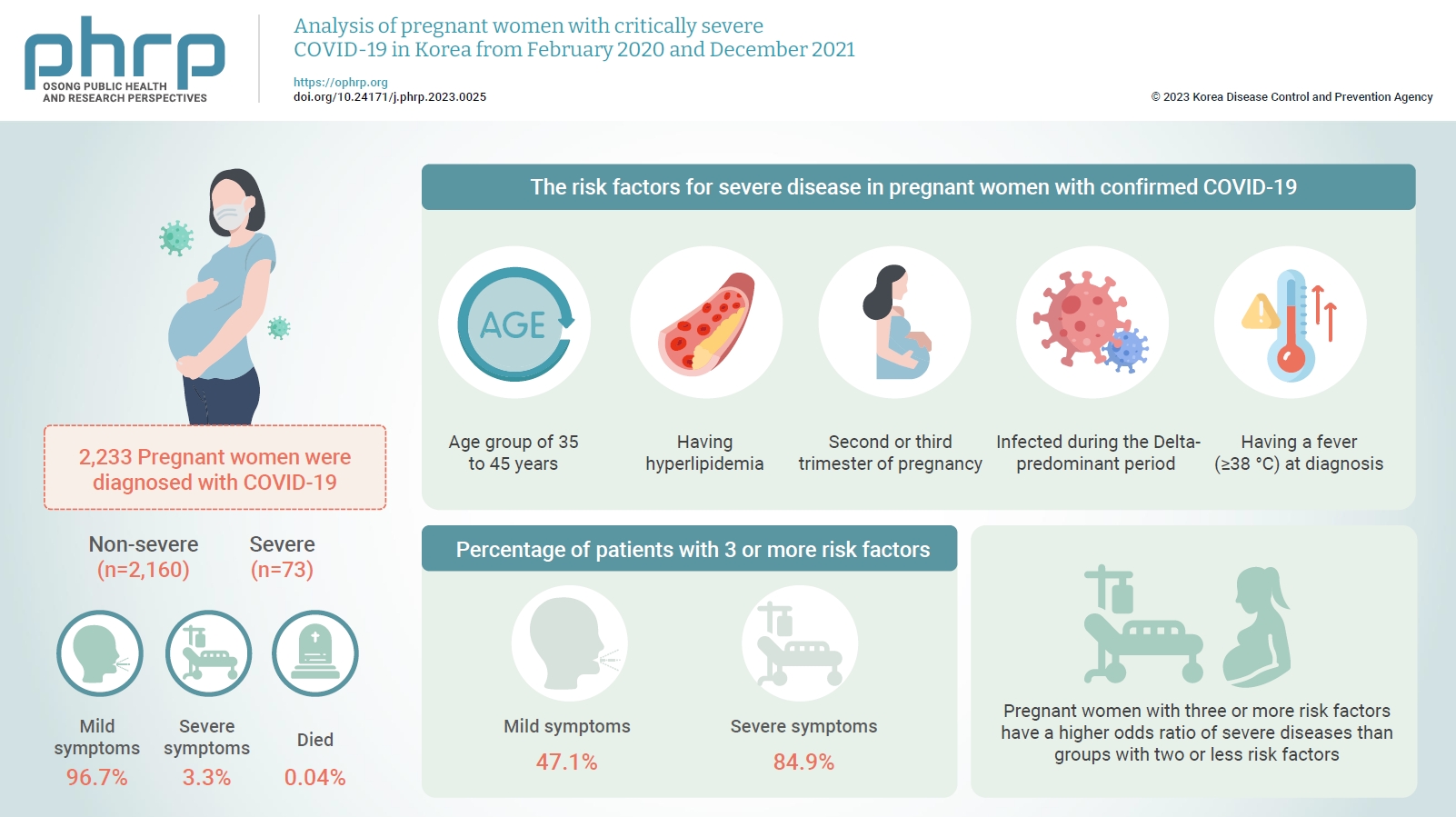
- Objectives
This study aimed to describe the characteristics and risk factors for severe disease in pregnant women infected with coronavirus disease 2019 (COVID-19) from the early days of the COVID-19 epidemic in Korea to the predominant period of the Delta variant.
Methods
A retrospective cohort study was conducted among pregnant women diagnosed with COVID-19 between February 2020 and December 2021. Logistic regression analysis was performed to compare severe and mild cases after adjusting for pregnant women’s age, nationality, infection route, outbreak area, infection period, symptoms, underlying disease, smoking status, trimester, and COVID-19 vaccination status.
Results
In total, 2,233 pregnant women were diagnosed with COVID-19 by December 2021. Among these, 96.7% had mild symptoms, 3.3% had severe symptoms, and 0.04% died. The risk factors for severe disease in pregnant women with confirmed COVID-19 were being in the age group of 35 to 45 years, having hyperlipidemia, being in the second or third trimester of pregnancy at the time of COVID-19 diagnosis, being infected during the Delta-predominant period, and having a fever (≥38 °C) at diagnosis. Furthermore, 47.1% of patients in the mild group and 84.9% of patients in the severe group had 3 or more risk factors.
Conclusion
Pregnant women with COVID-19 mainly experienced mild symptoms, but those with risk factors were at a higher risk of developing severe symptoms. Therefore, treatment and follow-up management should be thoroughly implemented.
- Early countermeasures to COVID-19 at long-term care facilities in Gwangju Metropolitan City, Republic of Korea
- Hye-Jin Kim, Jieun Kim, Yoon Suk Jang, Hanul Park, Jong Mu Kim, Young Joon Park, So-Yeon Ryu, Jun Hwi Cho, So Yeong Park, Sang-Eun Lee
- Osong Public Health Res Perspect. 2023;14(1):59-65. Published online February 1, 2023
- DOI: https://doi.org/10.24171/j.phrp.2022.0293
- 1,883 View
- 79 Download
-
 Graphical Abstract
Graphical Abstract
 Abstract
Abstract
 PDF
PDF 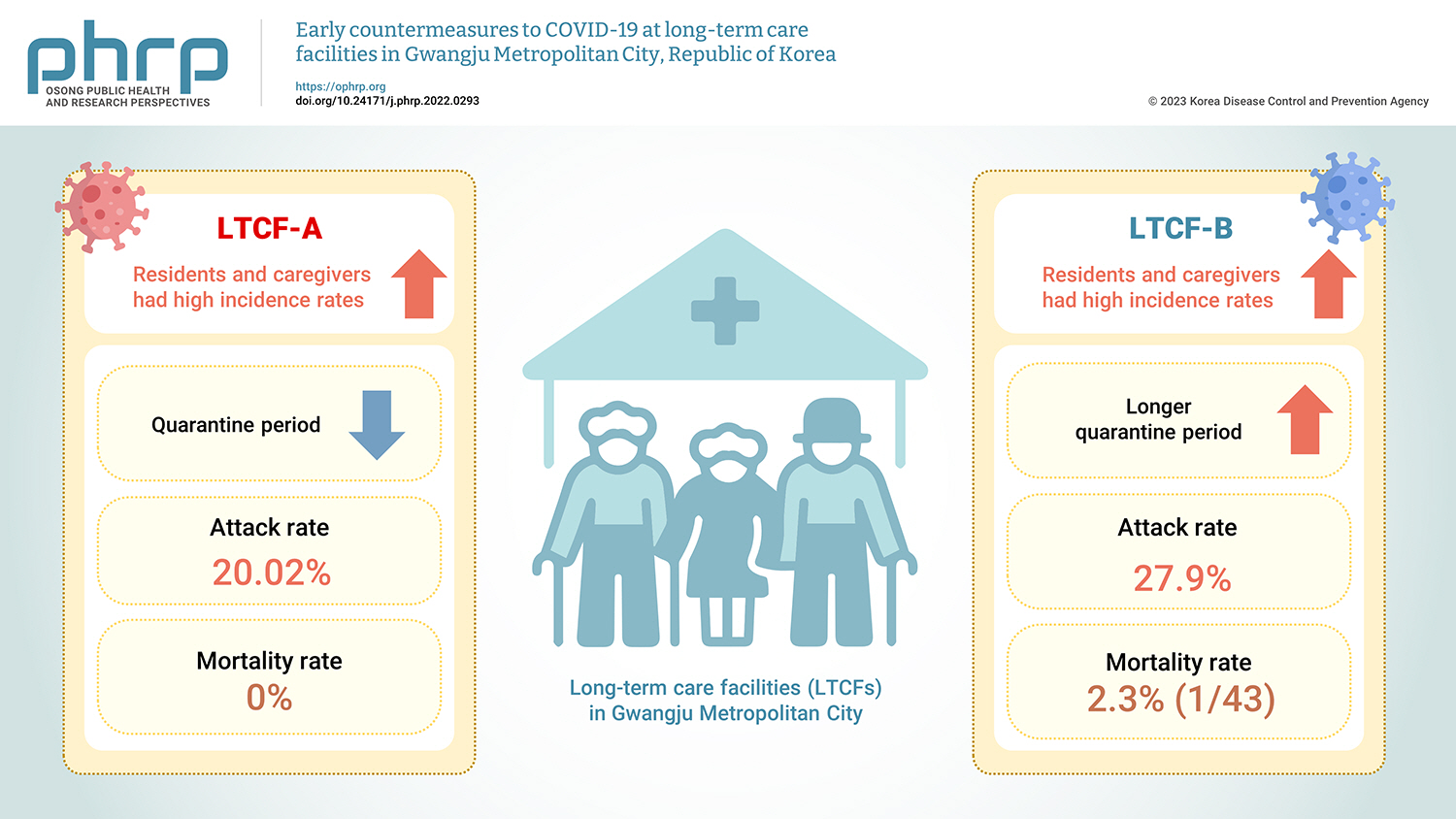
- Objectives
The coronavirus disease 2019 (COVID-19) pandemic has continued since its first detection in the Republic of Korea on January 20, 2020. This study describes the early countermeasures used to minimize the risk of COVID-19 outbreaks during cohort quarantine and compares the epidemiological characteristics of 2 outbreaks in long-term care facilities (LTCFs) in Gwangju Metropolitan City in summer 2020. Methods: An epidemiological investigation was conducted via direct visits. We investigated epidemiological characteristics, including incidence, morbidity, and mortality rates, for all residents and staff members. Demographic characteristics were analyzed using a statistical program. Additionally, the method of managing infection in LTCFs is described. Results: Residents and caregivers had high incidence rates in LTCF-A and LTCF-B, respectively. LTCF-B had a longer quarantine period than LTCF-A. The attack rate was 20.02% in LTCF-A and 27.9% in LTCF-B. The mortality rate was 2.3% (1/43) in LTCF-B, the only facility in which a COVID-19 death occurred. Conclusion: Extensive management requires contact minimization, which involves testing all contacts to mitigate further transmission in the early stages of LTCF outbreaks. The findings of this study can help inform and prepare public health authorities for COVID-19 outbreaks, particularly for early control in vulnerable facilities.
- 2019 Tabletop Exercise for Laboratory Diagnosis and Analyses of Unknown Disease Outbreaks by the Korea Centers for Disease Control and Prevention
- Il-Hwan Kim, Jun Hyeong Jang, Su-Kyoung Jo, Jin Sun No, Seung-Hee Seo, Jun-Young Kim, Sang-Oun Jung, Jeong-Min Kim, Sang-Eun Lee, Hye-Kyung Park, Eun-Jin Kim, Jun Ho Jeon, Myung-Min Choi, Boyeong Ryu, Yoon Suk Jang, Hwami Kim, Jin Lee, Seung-Hwan Shin, Hee Kyoung Kim, Eun-Kyoung Kim, Ye Eun Park, Cheon-Kwon Yoo, Sang-Won Lee, Myung-Guk Han, Gi-Eun Rhie, Byung Hak Kang
- Osong Public Health Res Perspect. 2020;11(5):280-285. Published online October 22, 2020
- DOI: https://doi.org/10.24171/j.phrp.2020.11.5.03
- 5,863 View
- 106 Download
-
 Abstract
Abstract
 PDF
PDF Objectives The Korea Centers for Disease Control and Prevention has published “A Guideline for Unknown Disease Outbreaks (UDO).” The aim of this report was to introduce tabletop exercises (TTX) to prepare for UDO in the future.
Methods The UDO Laboratory Analyses Task Force in Korea Centers for Disease Control and Prevention in April 2018, assigned unknown diseases into 5 syndromes, designed an algorithm for diagnosis, and made a panel list for diagnosis by exclusion. Using the guidelines and laboratory analyses for UDO, TTX were introduced.
Results Since September 9th, 2018, the UDO Laboratory Analyses Task Force has been preparing TTX based on a scenario of an outbreak caused by a novel coronavirus. In December 2019, through TTX, individual missions, epidemiological investigations, sample treatments, diagnosis by exclusions, and next generation sequencing analysis were discussed, and a novel coronavirus was identified as the causal pathogen.
Conclusion Guideline and laboratory analyses for UDO successfully applied in TTX. Conclusions drawn from TTX could be applied effectively in the analyses for the initial response to COVID-19, an ongoing epidemic of 2019 – 2020. Therefore, TTX should continuously be conducted for the response and preparation against UDO.
- Detection of Novel Coronavirus on the Surface of Environmental Materials Contaminated by COVID-19 Patients in the Republic of Korea
- Sang-Eun Lee, Deog-Yong Lee, Wook-Gyo Lee, ByeongHak Kang, Yoon Suk Jang, Boyeong Ryu, SeungJae Lee, Hyunjung Bahk, Eungyu Lee
- Osong Public Health Res Perspect. 2020;11(3):128-132. Published online May 8, 2020
- DOI: https://doi.org/10.24171/j.phrp.2020.11.3.03
- 8,856 View
- 281 Download
- 45 Web of Science
- 22 Crossref
-
 Abstract
Abstract
 PDF
PDF This study aimed to determine the presence of SARS-CoV-2 on surfaces frequently touched by COVID-19 patients, and assess the scope of contamination and transmissibility in facilities where the outbreaks occurred. In the course of this epidemiological investigation, a total of 80 environmental specimens were collected from 6 hospitals (68 specimens) and 2 “mass facilities” (6 specimens from a rehabilitation center and 6 specimens from an apartment building complex). Specific reverse transcriptase-polymerase chain reaction targeting of RNA-dependent RNA polymerase, and envelope genes, were used to identify the presence of this novel coronavirus. The 68 specimens from 6 hospitals (A, B, C, D, E, and G), where prior disinfection/cleaning had been performed before environmental sampling, tested negative for SARS-CoV-2. However, 2 out of 12 specimens (16.7%) from 2 “mass facilities” (F and H), where prior disinfection/cleaning had not taken place, were positive for SARS-CoV-2 RNA polymerase, and envelope genes. These results suggest that prompt disinfection and cleaning of potentially contaminated surfaces is an effective infection control measure. By inactivating SARS-CoV-2 with disinfection/cleaning the infectivity and transmission of the virus is blocked. This investigation of environmental sampling may help in the understanding of risk assessment of the COVID-19 outbreak in “mass facilities” and provide guidance in using effective disinfectants on contaminated surfaces.
-
Citations
Citations to this article as recorded by- Assessing the impact of architectural and behavioral interventions for controlling indoor COVID-19 infection risk: An agent-based approach
Anxiao Zhang, Qi Zhen, Chi Zheng, Jing Li, Yue Zheng, Yiming Du, Qiong Huang, Qi Zhang
Journal of Building Engineering.2023; 74: 106807. CrossRef - Advancements in COVID-19 Testing: An In-depth Overview
Rajesh Kumar, Seetha Harilal, Abdullah G. Al-Sehemi, Mehboobali Pannipara, Githa Elizabeth Mathew, Bijo Mathew
Current Pharmaceutical Biotechnology.2023; 24(9): 1122. CrossRef - Coronavirus disease 2019 (COVID-19) research agenda for healthcare epidemiology
Lona Mody, Ibukunoluwa C. Akinboyo, Hilary M. Babcock, Werner E. Bischoff, Vincent Chi-Chung Cheng, Kathleen Chiotos, Kimberly C. Claeys, K. C. Coffey, Daniel J. Diekema, Curtis J. Donskey, Katherine D. Ellingson, Heather M. Gilmartin, Shruti K. Gohil, An
Infection Control & Hospital Epidemiology.2022; 43(2): 156. CrossRef - SARS-CoV-2 on Surfaces and HVAC Filters in Dormitory Rooms
Jin Pan, Seth A. Hawks, Aaron J. Prussin, Nisha K. Duggal, Linsey C. Marr
Environmental Science & Technology Letters.2022; 9(1): 71. CrossRef - COVID-19 Cluster Linked to Aerosol Transmission of SARS-CoV-2 via Floor Drains
Taewon Han, Heedo Park, Yungje Jeong, Jungmin Lee, Eungyeong Shon, Man-Seong Park, Minki Sung
The Journal of Infectious Diseases.2022; 225(9): 1554. CrossRef - Environmental Contamination with SARS-CoV-2 in Hospital COVID Department: Antigen Test, Real-Time RT-PCR and Virus Isolation
Urška Rozman, Lea Knez, Goran Novak, Jernej Golob, Anita Pulko, Mojca Cimerman, Matjaž Ocepek, Urška Kuhar, Sonja Šostar Turk
COVID.2022; 2(8): 1050. CrossRef - Using Environmental Sampling to Enable Zoonotic Pandemic Preparedness
Avirup Sanyal, Sanskriti Agarwal, Uma Ramakrishnan, Kritika M. Garg, Balaji Chattopadhyay
Journal of the Indian Institute of Science.2022; 102(2): 711. CrossRef - Anforderungen an die Hygiene bei der Reinigung und Desinfektion von Flächen
Bundesgesundheitsblatt - Gesundheitsforschung - Ge.2022; 65(10): 1074. CrossRef - SARS-CoV-2 pandemic: a review of molecular diagnostic tools including sample collection and commercial response with associated advantages and limitations
Harikrishnan Jayamohan, Christopher J. Lambert, Himanshu J. Sant, Alexander Jafek, Dhruv Patel, Haidong Feng, Michael Beeman, Tawsif Mahmood, Ugochukwu Nze, Bruce K. Gale
Analytical and Bioanalytical Chemistry.2021; 413(1): 49. CrossRef - Contamination of inert surfaces by SARS-CoV-2: Persistence, stability and infectivity. A review
Montse Marquès, José L. Domingo
Environmental Research.2021; 193: 110559. CrossRef - A Systematic Review of Surface Contamination, Stability, and Disinfection Data on SARS-CoV-2 (Through July 10, 2020)
Noah Bedrosian, Elizabeth Mitchell, Elsa Rohm, Miguel Rothe, Christine Kelly, Gabrielle String, Daniele Lantagne
Environmental Science & Technology.2021; 55(7): 4162. CrossRef - Transmission of Severe Acute Respiratory Syndrome Coronavirus 2 via Contaminated Surfaces: What Is to Be Done?
Craig S Conover
Clinical Infectious Diseases.2021; 72(11): 2062. CrossRef - Investigation of SARS CoV-2 virus in environmental surface
Abdollah Dargahi, Farhad Jeddi, Mehdi Vosoughi, Chiman Karami, Aidin Hadisi, S. Ahamad Mokhtari, Hasan Ghobadi, Morteza Alighadri, Somayeh Biparva Haghighi, Hadi Sadeghi
Environmental Research.2021; 195: 110765. CrossRef - Ist die Desinfektion öffentlicher Flächen zur Prävention von SARS-CoV-2 – infektionen sinnvoll?
Günter Kampf, Lutz Jatzwauk
Das Gesundheitswesen.2021; 83(03): 180. CrossRef - SARS-CoV-2 Detection Rates from Surface Samples Do Not Implicate Public Surfaces as Relevant Sources for Transmission
Günter Kampf, Stephanie Pfaender, Emanuel Goldman, Eike Steinmann
Hygiene.2021; 1(1): 24. CrossRef - The SARS-CoV-2 (COVID-19) pandemic in hospital: An insight into environmental surfaces contamination, disinfectants’ efficiency, and estimation of plastic waste production
Faezeh seif, Zahra Noorimotlagh, Seyyed Abbas Mirzaee, Mojtaba Kalantar, Barat Barati, Mahdi Emamian Fard, Nozar Kalantar Fard
Environmental Research.2021; 202: 111809. CrossRef - Prevalence of SARS-CoV-2 RNA on inanimate surfaces: a systematic review and meta-analysis
Simone Belluco, Marzia Mancin, Filippo Marzoli, Alessio Bortolami, Eva Mazzetto, Alessandra Pezzuto, Michela Favretti, Calogero Terregino, Francesco Bonfante, Roberto Piro
European Journal of Epidemiology.2021; 36(7): 685. CrossRef - Management following the first confirmed case of SARS-CoV-2 in a domestic cat associated with a massive outbreak in South Korea
Taewon Han, Boyeong Ryu, Suyeon Lee, Yugyeong Song, Yoongje Jeong, Ilhwan Kim, Jeongmin Kim, Eunjin Kim, Wonjun Lee, Hyunju Lee, Haekyoung Hwang
One Health.2021; 13: 100328. CrossRef - Non-Respiratory Droplet Transmission of COVID-19 in the Isolation Ward of a Secondary Hospital in Oman
Zayid K. Al Mayahi, Nawal Al Kindi, Nasser Al Shaqsi, Noaman Al Hattali, Azza Al Hattali, Khalid Salim, Mark Beatty
Infectious Diseases in Clinical Practice.2021; 29(6): e371. CrossRef - Effectiveness of antiviral metal and metal oxide thin-film coatings against human coronavirus 229E
Louis-Vincent Delumeau, Hatameh Asgarimoghaddam, Tamiru Alkie, Alexander James Bryan Jones, Samantha Lum, Kissan Mistry, Marc G. Aucoin, Stephanie DeWitte-Orr, Kevin P. Musselman
APL Materials.2021;[Epub] CrossRef - Rapid Review of SARS-CoV-1 and SARS-CoV-2 Viability, Susceptibility to Treatment, and the Disinfection and Reuse of PPE, Particularly Filtering Facepiece Respirators
José G. B. Derraik, William A. Anderson, Elizabeth A. Connelly, Yvonne C. Anderson
International Journal of Environmental Research an.2020; 17(17): 6117. CrossRef - Potential sources, modes of transmission and effectiveness of prevention measures against SARS-CoV-2
G. Kampf, Y. Brüggemann, H.E.J. Kaba, J. Steinmann, S. Pfaender, S. Scheithauer, E. Steinmann
Journal of Hospital Infection.2020; 106(4): 678. CrossRef
- Assessing the impact of architectural and behavioral interventions for controlling indoor COVID-19 infection risk: An agent-based approach
- Prevalence of
Clonorchis sinensis Infections Along the Five Major Rivers in Republic of Korea, 2007 - Hyun-Kyung Kim, Hyeng-Il Cheun, Byung-Suk Cheun, Ki-Yeon Lee, Tong-Soo Kim, Sang-Eun Lee, Won-ja Lee, Shin-Hyeong Cho
- Osong Public Health Res Perspect. 2010;1(1):43-49. Published online December 31, 2010
- DOI: https://doi.org/10.1016/j.phrp.2010.12.010
- 2,685 View
- 12 Download
- 21 Crossref
-
 Abstract
Abstract
 PDF
PDF - Objectives
The prevalence of Clonorchis sinensis infection was investigated among residents of the five major river basins, that is, Hangang, Nakdonggang, Seomjingang, Yeongsangang, and Geumgang River basins in Korea.
Methods
From January to December 2007, a total of 31,268 stool samples were collected from 29 localities and examined by the formalin-ether sedimentation technique.
Results
Intestinal parasite eggs and/or protozoan cysts were detected from 2957 (9.5%) inhabitants. Number of residents harbouring helminth eggs in the faeces was 2542 (8.1%) for C. sinensis, 255 (0.8%) for Heterophyes spp., 36 (0.1%) for Echinostoma spp., 30 (0.1%) for Trichuris trichiura, 8 (0.03%) for Ascaris lumbricoides, 7 (0.02%) for Gymnophalloide seoi, and 50 (0.02%) for Trichostrongylus orientalis. Number of residents harbouring protozoan cysts in the faeces was 133 (1.3%) for Entamoeba spp. and 50 (0.2%) for Giardia lamblia. The positive rates of C. sinensis in Nakdonggang, Seomjingang, Yeongsangang, Geumgang, and Hangang River basins were 12.2%, 9.5%, 3.3%, 3.0%, and 1.0%, respectively. The egg positive rate of C. sinensis was higher in male (10.6%) than in female (6.1%), and the age group of 50s had the highest positive rate (10.4%).
Conclusion
The result of this study revealed little decrease in positive rate of C. sinensis compared with the result of southern endemic areas of Korea in 2006. -
Citations
Citations to this article as recorded by- Infection characteristics of Metagonimus species (Digenea: Heterophyidae) metacercariae in fish from major rivers of Korea
Woon-Mok Sohn
Parasites, Hosts and Diseases.2024; 62(1): 1. CrossRef - Global prevalence of 4 neglected foodborne trematodes targeted for control by WHO: A scoping review to highlight the gaps
Rachel Tidman, Kaushi S. T. Kanankege, Mathieu Bangert, Bernadette Abela-Ridder, Paul R. Torgerson
PLOS Neglected Tropical Diseases.2023; 17(3): e0011073. CrossRef - Infection Characteristics of Clonorchis sinensis Metacercariae in Fish from Republic of Korea
Woon-Mok Sohn
The Korean Journal of Parasitology.2022; 60(2): 79. CrossRef - High Endemicity with Clonorchis sinensis Metacercariae in Fish from Yongjeon-cheon (Stream) in Cheongsong-gun, Gyeongsangbuk-do, Korea
Woon-Mok Sohn, Byoung-Kuk Na, Shin-Hyeong Cho, Hee Il Lee, Myoung-Ro Lee, Jung-Won Ju, Gou Ok Kim
The Korean Journal of Parasitology.2021; 59(1): 97. CrossRef - Survey of Zoonotic Trematode Metacercariae in Fish from Water Systems of Geum-gang (River) in Republic of Korea
Woon-Mok Sohn, Byoung-Kuk Na, Shin-Hyeong Cho, Cheon-Hyeon Kim, Min-Ah Hwang, Kyeong-Woo No, Jai-Dong Kim
The Korean Journal of Parasitology.2021; 59(1): 23. CrossRef - Risk Factors for Clonorchis sinensis Infection in Residents of Binyang, Guangxi: A Cross-Sectional and Logistic Analysis Study
Meng Xu, Yanyan Jiang, Jianhai Yin, Shengkui Cao, Yujuan Shen, Jianping Cao
Frontiers in Public Health.2021;[Epub] CrossRef - Prevalence and Infection Intensity of Zoonotic Trematode Metacercariae in Fish from Soyang-cheon (Stream), in Wanju-gun, Jeollabuk-do, Korea
Woon-Mok Sohn, Byoung-Kuk Na, Shin-Hyeong Cho, Jung-Won Ju, Cheon-Hyeon Kim, Min-Ah Hwang, Kyeong-Woo No, Jong-Ho Park
The Korean Journal of Parasitology.2021; 59(3): 265. CrossRef - Survey of Zoonotic Trematode Metacercariae in Fish from Irrigation Canal of Togyo-jeosuji (Reservoir) in Cheorwon-gun, Gangwon-do, Republic of Korea
Woon-Mok Sohn, Byoung-Kuk Na, Shin-Hyeong Cho, Hee Il Lee, Jung-Won Ju, Myoung-Ro Lee, Eun-Joo Lim, Sung Yong Son, Eunmi Ko, Jaeseok Choi
The Korean Journal of Parasitology.2021; 59(4): 427. CrossRef - Endemicity of Zoonotic Trematode Metacercariae in Fish from Deokcheon-gang (River) in Sancheong-gun, Gyeongsangnam-do, Republic of Korea
Woon-Mok Sohn, Byoung-Kuk Na, Shin-Hyeong Cho, Hee Il Lee, Jung-Won Ju, Myoung-Ro Lee, Jeong-Gil Park, Jihee Ahn
The Korean Journal of Parasitology.2021; 59(5): 523. CrossRef - Prevalence of Clonorchis sinensis infection in fish in South‐East Asia: A systematic review and meta‐analysis
Ying Zhang, Qing‐Long Gong, Qing‐Bo Lv, Yang‐Yuan Qiu, Yan‐Chun Wang, Hong‐Yu Qiu, Xin‐Rui Guo, Jun‐Feng Gao, Qiao‐Cheng Chang, Chun‐Ren Wang
Journal of Fish Diseases.2020; 43(11): 1409. CrossRef - Infection Status with Clonorchis sinensis Metacercariae in Fish from Yangcheon (Stream) in Sancheong-gun, Gyeongsangnam-do, Korea
Woon-Mok Sohn, Byoung-Kuk Na, Shin-Hyeong Cho, Jung-Won Ju
The Korean Journal of Parasitology.2019; 57(2): 145. CrossRef - Prevalence, Species Distribution, and Related Factors of Fish-Borne Trematode Infection in Ninh Binh Province, Vietnam
Anh Kieu Thi Tran, Hoa Thuy Doan, Anh Ngoc Do, Van Thi Nguyen, Su Xuan Hoang, Huong Thu Thi Le, Hoa Thi Hoang, Nam Hoang Le, Quyen Bao Thi Le, Tran-Anh Le
BioMed Research International.2019; 2019: 1. CrossRef - Infection Status with Digenetic Trematode Metacercariae in Fishes from Coastal Lakes in Gangwon-do, Republic of Korea
Woon-Mok Sohn, Byoung-Kuk Na, Shin-Hyeong Cho, Soon-Won Lee
The Korean Journal of Parasitology.2019; 57(6): 681. CrossRef - Recombinant adenylate kinase 3 from liver fluke Clonorchis sinensis for histochemical analysis and serodiagnosis of clonorchiasis
Soon Bin Kwon, Paul Kim, Hae Sun Woo, Tae Yun Kim, Ju Yeong Kim, Hye Min Lee, Yun Soo Jang, Eun-Min Kim, Tai-Soon Yong, Baik Lin Seong
Parasitology.2018; 145(12): 1531. CrossRef - Prevalence and Intensity of Clonorchis sinensis Metacercariae in Freshwater Fish from Wicheon Stream in Gunwi-gun, Gyeongsangbuk-do, Korea
Woon-Mok Sohn, Byoung-Kuk Na, Shin-Hyeong Cho, Jung-Won Ju, Dong-Chul Son
The Korean Journal of Parasitology.2018; 56(1): 41. CrossRef - Epidemiological and Clinical Parameters Features of Patients with Clonorchiasis in the Geum River Basin, Republic of Korea
Hee-Eun Shin, Myoung-Ro Lee, Jung-Won Ju, Byong-Suk Jeong, Mi-Yeoun Park, Keoung-Sook Lee, Shin-Hyeong Cho
Interdisciplinary Perspectives on Infectious Disea.2017; 2017: 1. CrossRef - A new method for estimating the prevalence of clonorchiasis in Korea
Jin-Young Jeong, Jin Yong Lee, Byung-Suk Chung, Younghyun Choi, Allison Baer Alley, Hyun Joo Kim
Medicine.2017; 96(13): e6536. CrossRef - Prevalence of Clonorchis sinensis Infection among Residents along 5 Major Rivers in the Republic of Korea
Young-Il Jeong, Hee-Eun Shin, Sang-Eun Lee, Hyeng-Il Cheun, Jung-Won Ju, Jung-Yeon Kim, Mi Yeoun Park, Shin-Hyeong Cho
The Korean Journal of Parasitology.2016; 54(2): 215. CrossRef - Trematode Metacercariae in Freshwater Fish from Water Systems of Hantangang and Imjingang in Republic of Korea
Woon-Mok Sohn, Byoung-Kuk Na, Shin-Hyeong Cho, Soon-Won Lee, Seung-Bong Choi, Won-Seok Seok
The Korean Journal of Parasitology.2015; 53(3): 289. CrossRef - Prevalence and Risk Factors of Clonorchiasis among Residents of Riverside Areas in Muju-gun, Jeollabuk-do, Korea
Do-Soon Park, Sung-Jin Na, Shin Hyeong Cho, Kyung Ja June, Young-Chae Cho, Young-Ha Lee
The Korean Journal of Parasitology.2014; 52(4): 391. CrossRef - Prevalence and Risk Factors of Clonorchiasis among the Populations Served by Primary Healthcare Posts along Five Major Rivers in South Korea
Kyung Ja June, Shin Hyeong Cho, Won Ja Lee, Chunmi Kim, Kyung-Soon Park
Osong Public Health and Research Perspectives.2013; 4(1): 21. CrossRef
- Infection characteristics of Metagonimus species (Digenea: Heterophyidae) metacercariae in fish from major rivers of Korea



 First
First Prev
Prev


